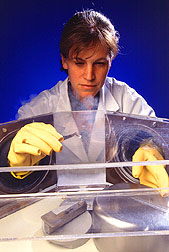|
|
|
At the USDA-ARS National Center for Genetic Resources Preservation, we store the genetic diversity of plants and animals important to US agriculture and landscapes. Our mission is to preserve viability of germplasm (propagules that can be used to regenerate a whole plant) for decades to centuries. My personal research is about how to obtain extreme longevity, endogenous differences among species that make our job easier or harder, and tools to confirm our longevity estimates or detect deterioration without having to germinate the seed. I like to think of it as 'extreme' biology – life under dry or cryogenic conditions. Saving Seeds for the Long TermWill seeds in storage today sprout and grow when they're needed--years, even centuries, from now? To find out, Agricultural Research Service plant physiologist Christina T. Walters is investigating little-known glass compounds in super-chilled seeds. "All seeds contain glasses that are composed of water and other cellular constituents," says Walters. "These aqueous glasses have properties similar to the silica glass in windows--except that they form at temperatures hundreds of degrees lower. Our data suggest that they consist of a highly complex intercellular substance--perhaps a carbohydrate or protein mixture." Some 300,000 germplasm accessions representing about 8,000 species are stored at the facility. It is the largest gene bank in the world and is part of the ARS-maintained National Plant Germplasm System (NPGS) that collects plants from all over the world. Curators and other scientists preserve, evaluate, and catalog the vast collections and distribute germplasm to breeders who use it to develop new varieties. If scientists could accurately predict seed viability, the continual monitoring of stored seeds would be unnecessary. "This monitoring for viability is the most labor-intensive part of seed storage in gene banks," says ARS plant physiologist Eric E. Roos, who heads the Plant Germplasm Preservation Research Unit at Fort Collins. A major goal is to identify seeds that are "good keepers" or to spot "bad keepers" before they begin to deteriorate and to develop predictive tools for the rate of deterioration. Walters found that two big influences on deterioration are the nature of water binding within seeds and the effect of the bound water on seed cells. Investigating further, she applied thermodynamics and concepts from materials and food sciences to predict optimal moisture content for storing any seed at any temperature. That's where seed glasses come in. "The glassy concept explains the role of water in food deterioration," says Walters. She uses this same concept to describe how seeds' intercellular tissue responds to changing water contents and temperature.
—Extracted from a longer article online By Hank Becker, Agricultural Research Service Information Staff, published in the September 1998 issue of Agricultural Research magazine. |

 Christina Walters is Research Leader for plant germplasm at the USDA-ARS National Center for Genetic Resources Preservation in Fort Collins, CO. She obtained her PhD in plant biology from Cornell, and then travelled to Fort Collins for a postdoctoral fellowship at the USDA, where she remains except for several visiting professorships at the Université Pierre et Marie Curie in Paris (where we hope she enjoyed the légumes.) Her major interest is in the long-term preservation of germ plasm, defined as the part of a seed that can generate a new plant. Many seeds are easy to store, but some, including very large ones like those of the avocado, present difficult problems for which Dr. Walters is a n aclaimed expert at discovering elegant solutions.
Christina Walters is Research Leader for plant germplasm at the USDA-ARS National Center for Genetic Resources Preservation in Fort Collins, CO. She obtained her PhD in plant biology from Cornell, and then travelled to Fort Collins for a postdoctoral fellowship at the USDA, where she remains except for several visiting professorships at the Université Pierre et Marie Curie in Paris (where we hope she enjoyed the légumes.) Her major interest is in the long-term preservation of germ plasm, defined as the part of a seed that can generate a new plant. Many seeds are easy to store, but some, including very large ones like those of the avocado, present difficult problems for which Dr. Walters is a n aclaimed expert at discovering elegant solutions.